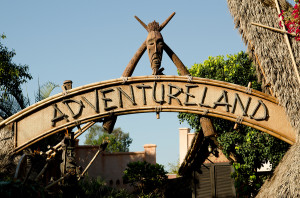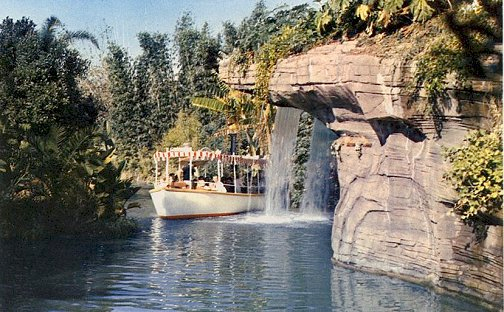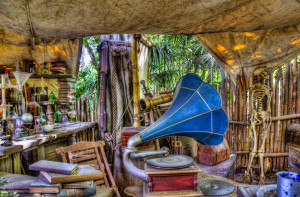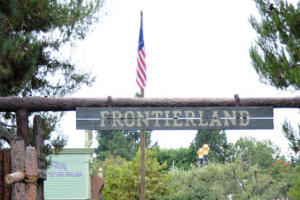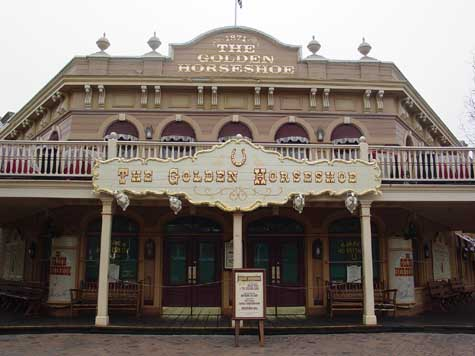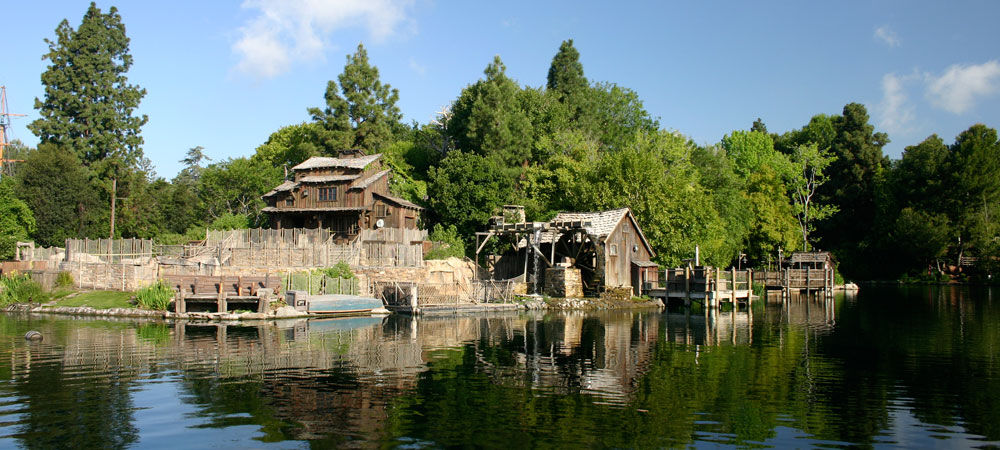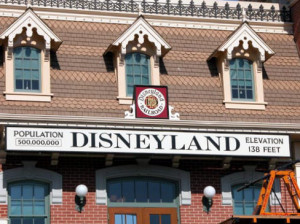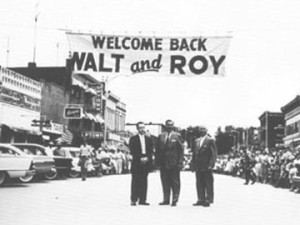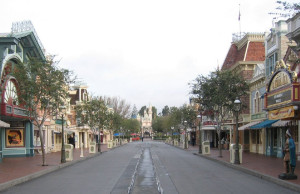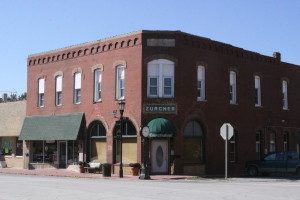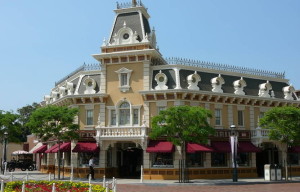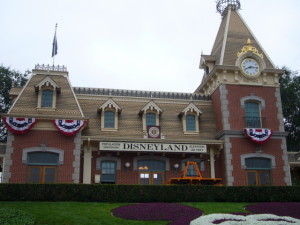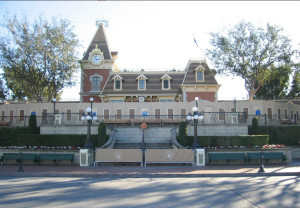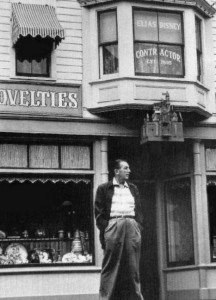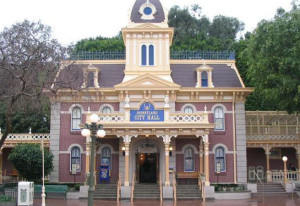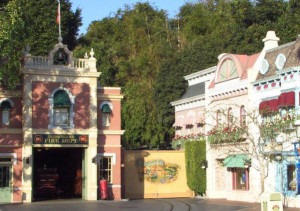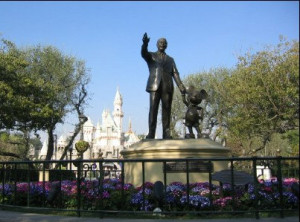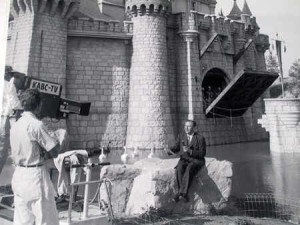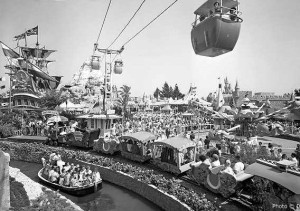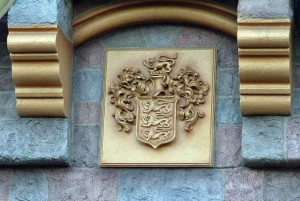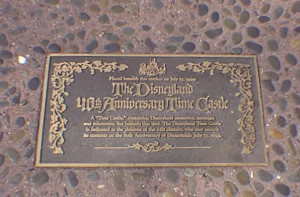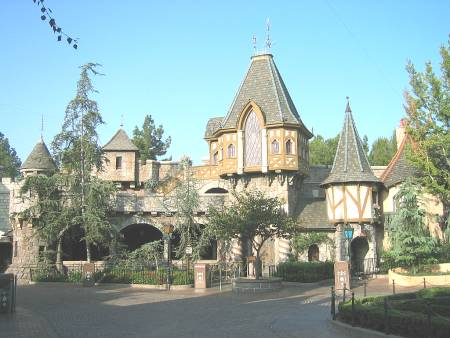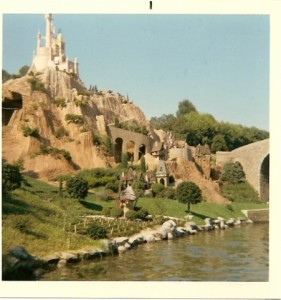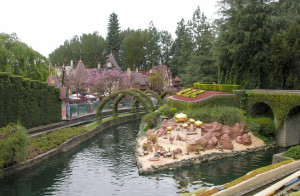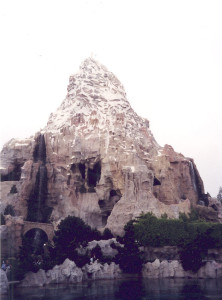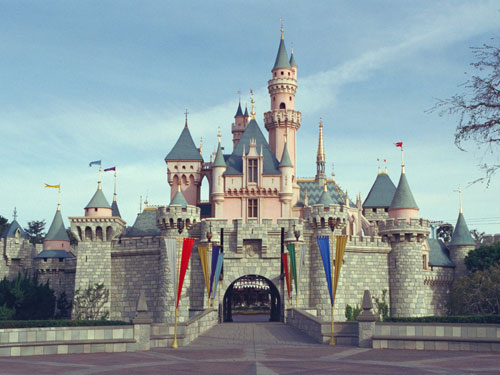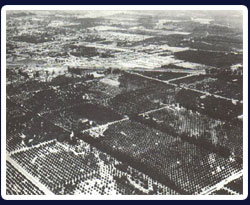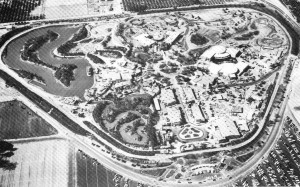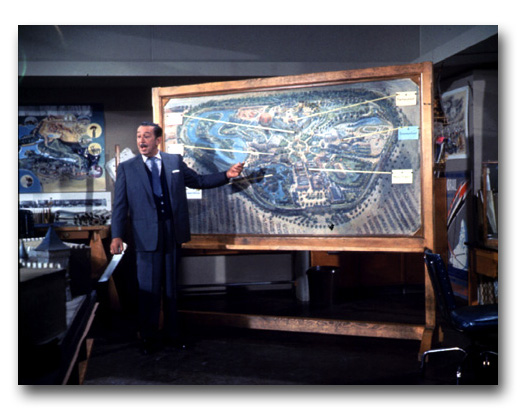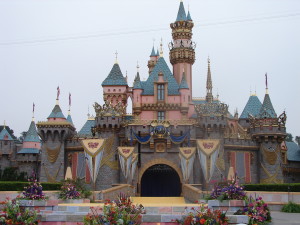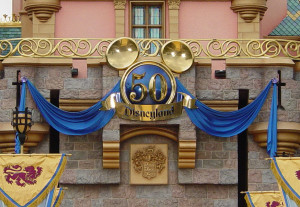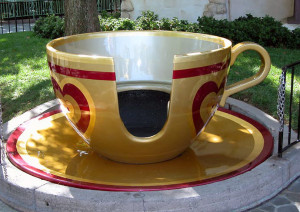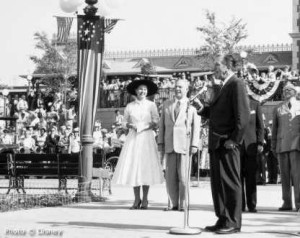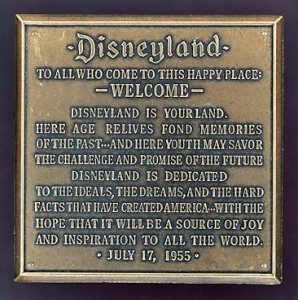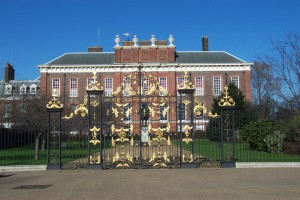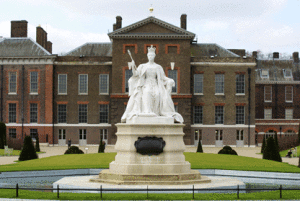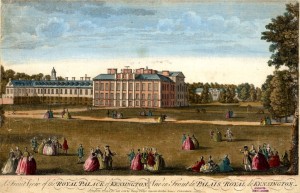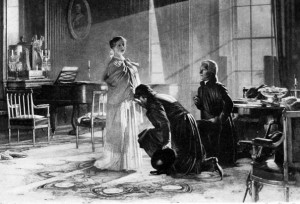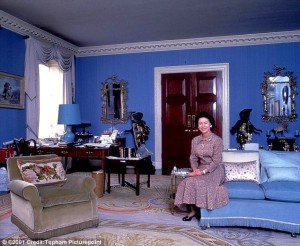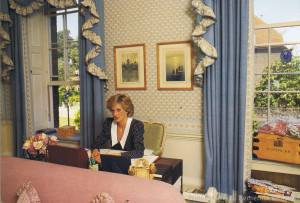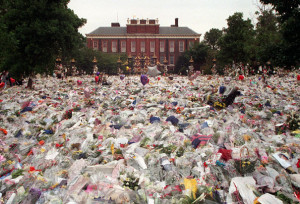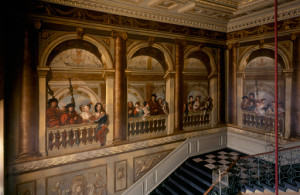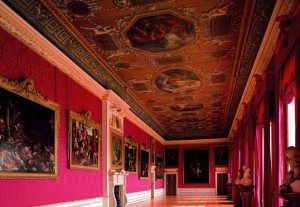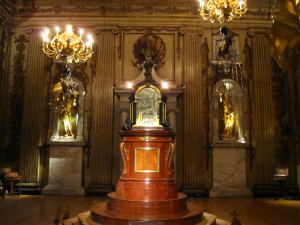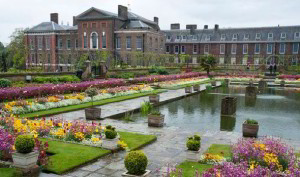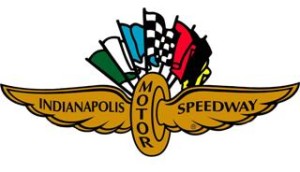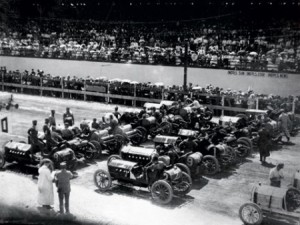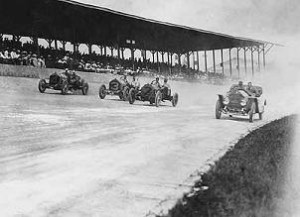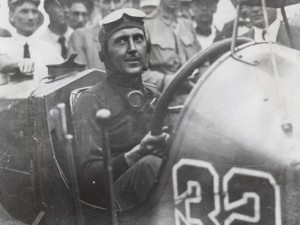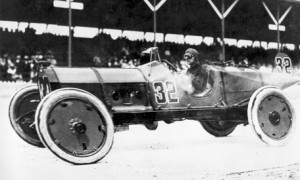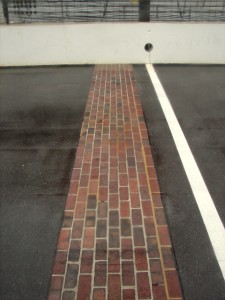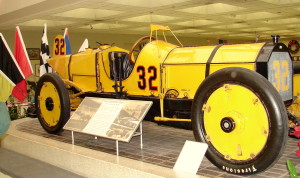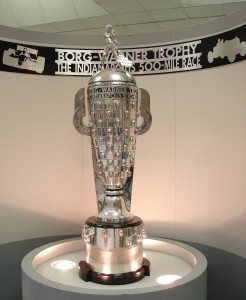In this third post of the Disneyland series I will discuss two more of the original “lands” of Disneyland, Adventureland and Frontierland. When Walt was planning the construction of Disneyland he wanted to incorporate the ideas used in the many successful Disney Studio movies and television shows. Adventureland was based on the Disney True-Life Adventure series and Frontierland was based on Walt’s love of the classic stories of Tom Sawyer and Davy Crockett, the Davy Crockett television show was a very popular Disney series of the 1950s. (Who remembers those coonskin hats that were a national craze way back then??)the
Adventureland
Adventureland is one of the smaller areas of Disneyland but special care was taken to recreate the feeling of an exotic tropical location found in the jungles of Asia and Africa. When the park opened in 1955, Adventureland was sparsely landscaped with plants, in fact the trees from the former orange groves on the site were uprooted and placed upside down around the area to fill in the empty spaces to stimulate exotic vegetation and weeds were labeled with strange scientific plant names.
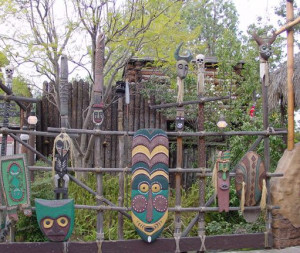
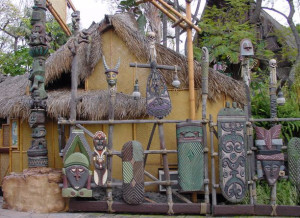
When Disneyland opened in 1955, the only attraction in Adventureland was the Jungle Cruise. Taking inspiration from the Disney True-Life Adventure series, the imagineers developed a ride that simulated a trip down the major rivers of Asia, Africa and South America. The trip is led by a Disney cast member who drives the boat past several different scenes while offering the guests a humorous narration. Originally the plan was to use live animals, but due to animal behavioral restrictions the imagineers instead created numerous animatronic animals so the scene was consistently the same for each ride. The boat design was inspired by the 1951 movie “The African Queen” and the river that the boat rides through is only 5 feet deep and is dyed a blue-green color to obscure the boat tracks, other mechanical equipment and platforms used for the animatronic animals. The Jungle Cruise river was originally 1,920 feet in length but it was shortened and rerouted twice, once in 1962 when the Swiss Family Treehouse attraction was added and again in 1994 for the Indiana Jones ride.
Located near the entrance to Adventureland is The Enchanted Tiki Room which opened in 1964 and it was the first attraction to feature a full cast of characters that used the technique developed by the Disney imagineers called audio-animatronics which was the computer synchronization of sound and robotics. The 15 minute show features songs performed by over 150 animatronic birds, tropical flower and plants, carved Tiki Totems and even a magical fountain located in the center of the room. Since 1976, the attraction has been sponsored by the Dole Food Company based in Hawaii, the theme of the attraction fits in perfectly with the tropical pineapple flavored frozen dessert, the Dole Whip, that is sold at the snack bar. Long time visitors to Disneyland will remember a small restaurant called the Tahitian Terrace which was located adjacent to the Enchanted Tiki Room. The restaurant served a variety of Polynesian food and also featured a show with Hawaiian musicians and dancers; the Polynesian culture was a very popular trend in Southern California during the early 1960s. The restaurant was only open during the summer months until it was permanently closed in 1994.
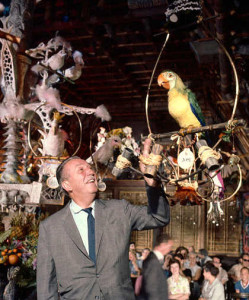
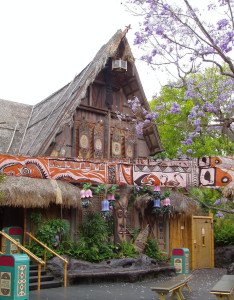
In 1962, the Swiss Family Treehouse attraction was added to Adventureland, it is inspired by the 1960 Disney movie of the same name which was based on the 1812 book written by Johanna David Wyss. The Swiss Family Treehouse was built in the area adjacent to Frointerland and the tree was officially given the Disney scientific name of “Disneyodendron semperfloren grandis” translated to mean a large ever-blooming artificial tree. The tree was constructed of steel and concrete and measures 60 feet tall and 90 feet wide with its 450 branches covered with over 6,000 artificial leaves. The Swiss Family Treehouse was a walk-through attraction and guests would climb the stairs into the treehouse to see the various rooms decorated with furniture and other items that the Robinson family supposedly salvaged from the ship wreak that caused them to be stranded on a deserted island.
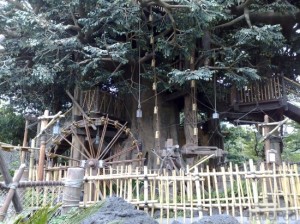
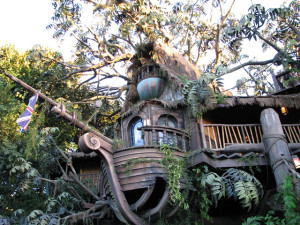
(Photo on left is Swiss Family Treehouse and on the right is Tarzan’s Treehouse)
The Swiss Family Treehouse operated for over 36 years until it was closed to be refurbished and reopened in 1999 as Tarzan’s Treehouse which coincided with the release of the Disney animated movie, “Tarzan”. The attraction was redecorated to reflects the style of the Tarzan movie. (Travel tip: Look closely for tributes to the older Swiss Family Treehouse attraction for such items as the “Mind Thy Head sign and the antique gramophone playing the “Swisskapolka” that were both used on the original attraction.
One of the most technically advanced rides in Disneyland is the Indiana Jones Adventure attraction which opened in 1995. To accommodate the space needed for the queue area and the large 50,000 square foot show building, the Jungle Cruise attraction was rerouted and an area of the former parking lot was removed. (An Eeyore parking sign is placed in the interior queue line as tribute, look for it in the projection room) On the ride guests board military vehicles to join the famous archaeologist Indiana Jones as he travels through a lost temple in search of hidden treasures but the idol Mara has been angered and guests set off on a wild adventure. The ride system was invented and patented by the Disney imaginer specifically for the Indiana Jones ride and each of the military vehicles is actually a motion simulator with three hydraulic systems attached underneath the chassis of the vehicle which can be operated independently creating a variety of motions that simulate speed, lift, reverse and other intense maneuvers. (Travel tip: If the queue line is long don’t worry because there are fun things to see and do while waiting in the various areas of the line, such as in the exterior queue line look for the small mining car that was used in the Temple of Doom movie, in the spike room shake one of the bamboo support poles for sounds of the ceiling crashing overhead and don’t pull on the rope in another area of the queue line because one of the archeologists will give an angry response and after ride as guests exit the ride’s show building look for the Mercedes-Benz truck which was actually used in Raiders of the Lost Ark movie)
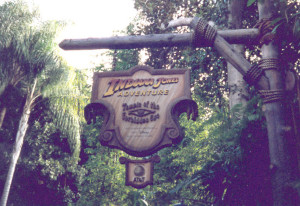
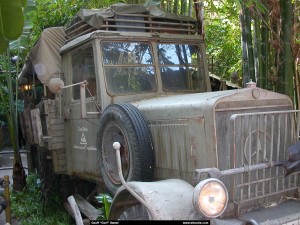
Frontierland
Frontierland is another original “land” of Disneyland and when the park being planned Western movies and television shows were very popular. After passing through the fort façade at the entrance to Frontierland guests will see the street and buildings reminiscent of a small western town with raised wooden sidewalks, hitching posts for horses, also on the far corner down the street is the Golden Horseshoe Saloon and the boat dock for the Mark Twain Riverboat is location on the edge of the Rivers of America. (Travel tip: Look for a tribute window to Fess Parker, the actor played Davy Crockett on the Disney television show that was very popular in the 1950s)
Just prior to the opening of Disneyland, Walt and Lillian Disney celebrated their 30th anniversary with a private party held at the Golden Horseshoe Saloon on July 13, 1955. Then the day before the official opening of the park, on July 16, 1955, another private party was held for the corporate sponsors of Disneyland and the event marked the first performance of the long running Golden Horseshoe Saloon Revue starring Wally Boag as Pecos Bill. The Golden Horseshoe Revue was the longest running show to be performed at Disneyland; it ran a record total of 39,000 times. Many years later, another popular show starring Bill Hill and the Hillibillies ran from 1994 to early 2014 and featured bluegrass music. An interesting trivia note regarding the Golden Horseshoe Saloon is that the famous Disney imagineer Harper Goff designed the interior and at the time that Disneyland was being built Goff had also recently designed a very similar set for the 1953 movie “Calamity Jane” starring Doris Day. (Travel tip: Look for a large petrified wood tree stump which is located just outside the Golden Horseshoe Saloon on the edge of the Rivers of America, is was a gift from Walt to his wife for their 31st anniversary … of course the clever Lillian thought that it would look much better placed in Disneyland for everyone to enjoy instead of her backyard!)
When Walt was planning Disneyland’s Frontierland, he wanted the Rivers of America to be busy with activity and the Mark Twain Riverboat was the perfect choice. The Mark Twain is a grand steamboat that was built to 5/8 scale and measures 28 feet high and 105 feet long and weighs 150 tons. The riverboat takes Disneyland guests on a 12 minute ride along the Rivers of America with wonderful views of Frontierland’s Tom Sawyer Island and New Orleans Square. Available for a select few guests is the exciting opportunity to ride the Mark Twain from the pilot’s wheelhouse located on the top deck of the boat where they can stand behind the wheel for a fun photo, pull the rope to sound the boat’s loud horn and after a trip around the river guests are presented with a special Pilot Certificate which makes a great souvenir! (Travel tip: On a trip around Tom Sawyer Island on board the Mark Twain, look for one of the old keel boats abandoned on the riverbank that guests will remember from years ago and also there is an old mine train standing on the tracks of the old Mine Train through Nature’s Wonderland attraction.
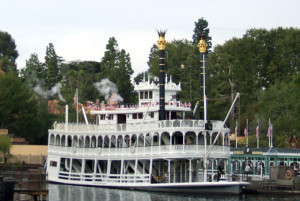
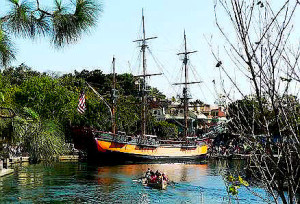
(Photo on the left is the Mark Twain and on the right is the Columbia)
After Disneyland had been open for several years, Walt decided that an additional large ship should be added to the Rivers of America. The Sailing Ship Columbia opened in 1958 and it is a full scale historical replica of the Columbia Rediviva that was the first American ship to travel around the world. When the 84 feet tall and 110 feet long ship was being built at the Todd Shipyard in San Pedro, Ca (the same place that the hull of the Mark Twain was made years earlier) Joe Fowler, the Disneyland construction boss and retired Naval admiral, told Disney that it was customary to put silver dollars under the mast of a ship for good luck and Disney personally placed one under each of the Columbia’s three masts. The Columbia only runs on very busy days at Disneyland and both the Columbia and the Mark Twain will close early on the nights when the Fantasmic! show is performed because both are used in the popular nighttime extravaganza that can be seen along the Rivers of America.
When Tom Sawyer Island opened in 1956 it was a magical place for children and adults visiting Disneyland to explore the artificial island located in the middle of the Rivers of America. For decades the Tom Sawyer themed island was reached only by the old keel boats (which closed in 177) and the river rafts and remained generally unchanged with areas such as, Tom and Huck’s Treehouse, Injun Joe’s Cave, Harper’s Mill, Fort Wilderness and on the far end of the island the Burning Settler’s Cave. When the nighttime show Fantasmic! debuted in 1992 the area of Harper’s Mill was re-built to accommodate the equipment needed for the special effects used in the production. Then after the success of the Disney Pirates of the Caribbean franchise the island closed for refurbishment and reopened in 2007 when it was re-themed as the Pirate’s Lair. The Harper’s Mill was renamed Lafitte’s Tavern where on occasion there is a performance by a pirate band called the Blige Rats, the former Injun Joe’s Cave has been changed with pirate sounds and interactive special effects and was renamed the Dead Man’s Grotto, the Smuggler’s Cove area of the island has also been changed with pirate themed refurbishments while the original Tom Sawyer Island old Suspension Bridge and Pontoon Bridge have remained intact. Two additional pirate themed areas were added to the island, the Pirate’s Den features the remains of a shipwreck and an area called the Captain’s Treasure which features a large pile of pirate loot and occasionally the character of Captain Jack Sparrow can be found there for a wonderful photo opportunity.
One of the most popular rides at Disneyland can be found in Frontierland and it is the Big Thunder Mountain attraction which is famously said to be “the wildest ride in the wilderness”! Big Thunder is an exciting mine train roller coaster that takes guests on a ride through an area that looks a lot like Utah’s Bryce Canyon, the backstory of the ride is that the miners have trespassed onto a Native American sacred area and the place has become cursed with severe natural disasters and the mine train careens out of control!! The Big Thunder attraction opened in 1979 on the site of the former Mine Train through Nature’s Wonderland and Rainbow Ridge Pack Mule attractions of old Frontierland. As a tribute to both those previous rides the small Rainbow Ridge mining town that was once located near the loading area of both attractions remains intact and the Rainbow Caverns that can be seen on the first lift of the Big Thunder attraction was also recreated as a special tribute to the former Frontierland attractions. In 2013, Big Thunder closed for a major refurbishment and reopened in March 2014 with a completely new track, trains, and a new “dynamic” ending that features enhanced special effects! (Travel tip: When riding the Big Thunder ride, as the train slowly drops to the right look for the audio-animatronic goat holding a stick of dynamite which is warning to the disaster to come!)

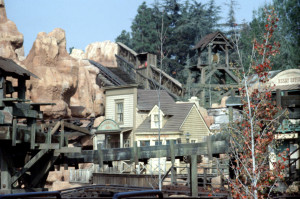
This post completes the tours of Adventureland and Frontierland but be sure to check out the four additional posts in the Disneyland series. Part One – The history of Disneyland, Part Two – Main Street and Fantasyland, Part Four – New Orleans Square and Critter Country, Part Five – Tomorrowland and Mickey’s Toontown.

